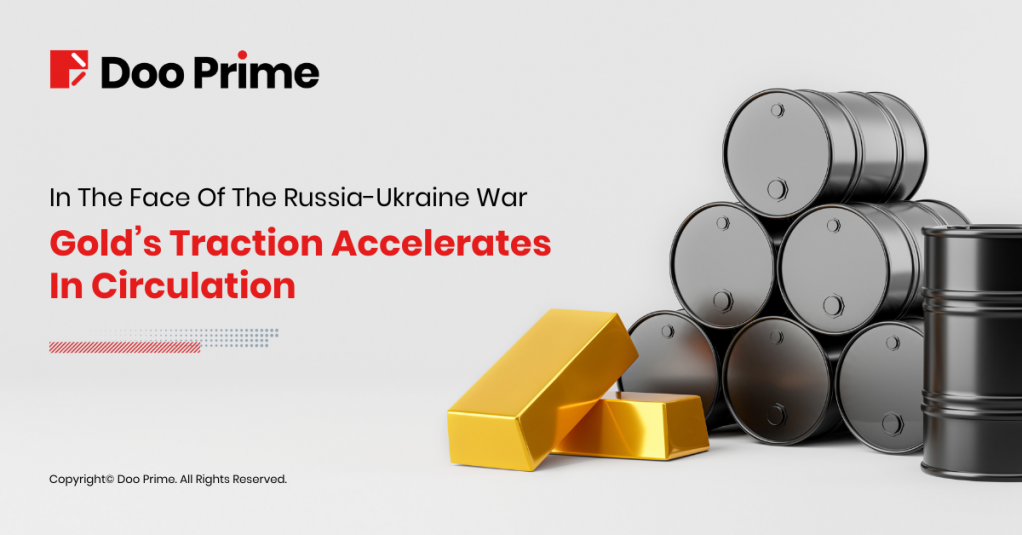
In our previous article, we covered how the sanctions on Russia affect the Oil and Gas market alongside how Commodity Trades Lead Markets Into Volatility Zone.
Historically, war events have generally been accompanied by a rise in gold prices. The Russia-Ukraine invasion, which began on 24th February 2022, has fuelled a rally in oil prices and industrial metals.
Russia is known as the top producer of palladium and platinum, and the world’s third-largest producer of gold, and this factor is adding up to the fluctuations of the financial markets during this on-going hiatus, especially with the U.S. announcement to block gold transactions that was done alongside the Group of Seven and European Union allies.
“We could see a pullback in gold if there is some positive news that comes out of the Russia-Ukraine conflict, but I think traders will look at that as a buying opportunity because of inflation fears,” RJO Futures senior market strategist Bob Haberkorn said.
How The Gold Market Reacted To The Invasion
The ongoing Russia-Ukraine conflict is building a war premium into the price of gold, and this premium will persist for as long as the conflict continues, say market experts.
On 24th February 2022, spot gold slipped as investors continued to assess the crisis in Ukraine, after Russian forces attacked the country on the orders of President Vladimir Putin.
Gold last traded at $1,897.76 per troy ounce, down by 0.5% on the previous day. Earlier in the morning, the precious metal was trading at $1,968.01 per ounce, up 3.17% and the highest since late 2020, as investors piled into safe-haven assets and equity markets globally tumbled into the red.
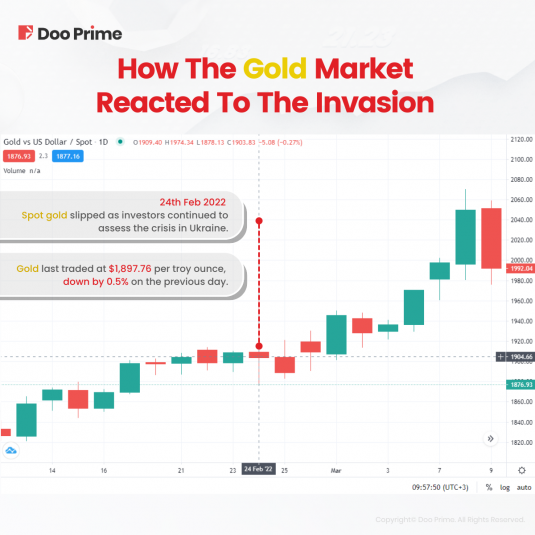
At the same time, U.S. gold futures were down 0.5% at $1,899.80 per ounce. The price of gold is up about 5.5% in February thus far, on course for its biggest monthly gain since July 2020.
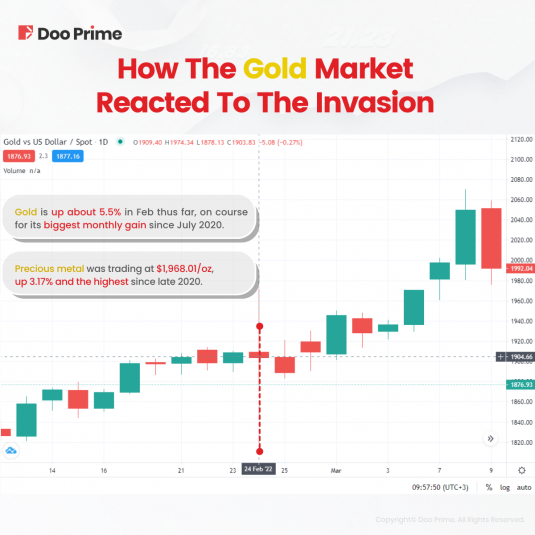
In a 9th March 2022 report, UOB Global Economics and Markets Research head of markets strategy Heng Koon How notes that the 8th March’s jump in gold spot prices was very close to the all-time high of $2,072 registered in August 2020. “The move (on 8th March 2022) was triggered by the announcement by the White House on the start of the U.S. embargo on Russian energy exports.

During this interval, gold surpassed $2,000 per ounce to hit a high of $2,069 per ounce on 8th March 2022 after the U.S. announced an import ban on Russian oil. As seen above, gold was trading at about $1,900 per ounce, prior to Russia’s invasion of Ukraine two weeks ago, setting a difference of $169.
The yellow metal has risen by 9%, closing at $1,997 per ounce on 9th March 2022 as investors parked their cash in gold. This is because gold is considered a safe haven in times of uncertainty.

By 18th April 2022, gold rose to a one-month high, just shy of the $2,000 per ounce level, as concerns around the on-going Russia-Ukraine conflict and rising inflationary pressures increased safe-haven bids for the precious metal.
Spot gold rose 0.1% to $1,976.56 per ounce by 2:09 p.m. ET, after earlier hitting its highest since 11th March 2022 at $1,998.10. U.S. gold futures settled 0.6% higher at $1,986.4.
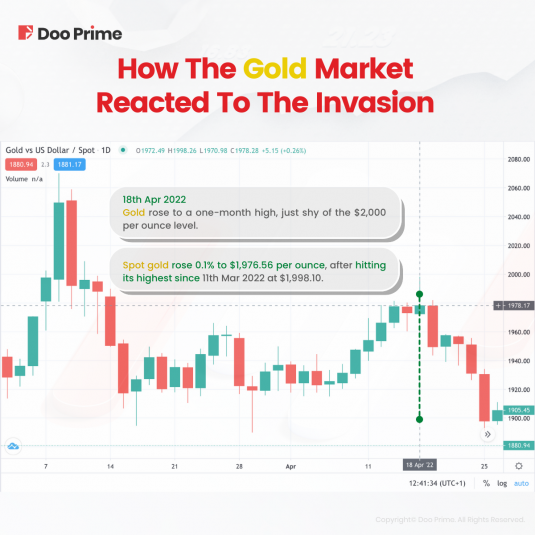
As of 25th April 2022, gold fell 1.7% to $1,897.01, while U.S. gold futures settled nearly 2% lower at $1,896.

In-Depth Analysis On Gold
Notably, gold prices have increased by more than $40, accelerating a well-defined upward trend that began in the first week of March.
“Gold has risen above $2,000 per ounce on increased demand for safe-haven assets as investors assess the geopolitical and economic consequences of Russia’s invasion of Ukraine,” said Kshitij Purohit, Lead of Commodities and Currencies CapitalVia Global Research.
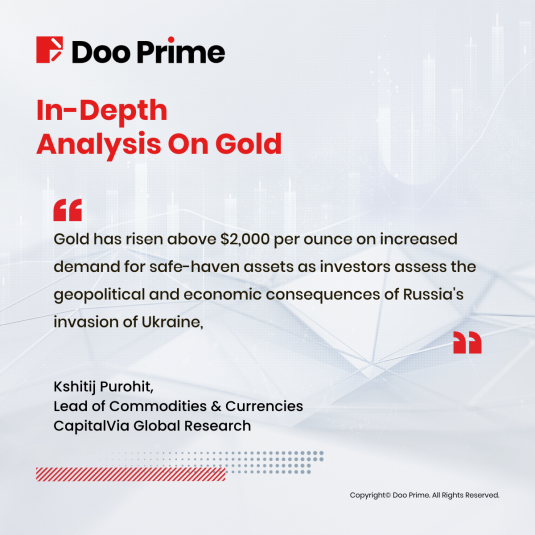
“There are numerous reasons to believe that gold will rise, not the least of which are geopolitical concerns. The crisis in Ukraine continues to produce a lot of anxiety, and as a result, people have been flocking to safety assets.”
According to Tapan Patel, Senior Analyst (Commodities), HDFC Securities: “The yellow metal rallied on geopolitical risk and inflation worries as Western world is mulling for harsher sanctions on Russia, including oil import ban.”
In addition, IIFL Securities VP, Research, Anuj Gupta said: “Geopolitical tension between Russia and Ukraine plays a supportive role for gold prices, however this environment is negative for global equity markets.”
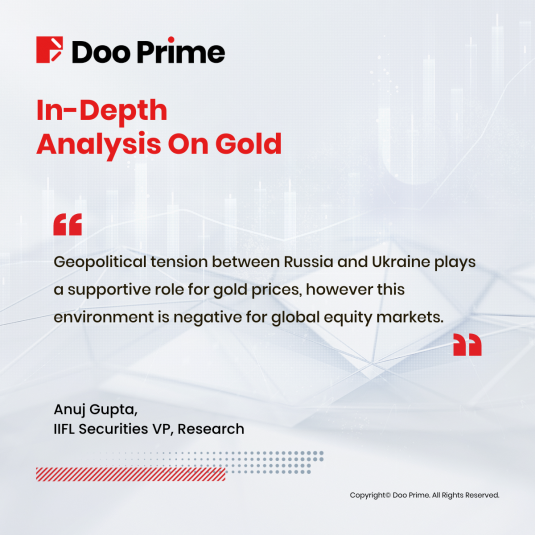
Experts said the transactions ban would in effect apply secondary sanctions on people who trade in gold with Russia.
“It is another way to close sanctions loopholes, and increase economic pressure on Russian entities,” Rachel Ziemba, an adjunct senior fellow at the Center for a New American Security, told The Associated Press news agency.
Also, gold’s advance was curbed late in the session by a jump in benchmark 10-year U.S. Treasury yields and further gains in the dollar, which dulls the appetite for gold among overseas buyers.
“The little step-up in tension due the Russia-Ukraine war with inflationary pressures across the board boosts safe-haven demand for gold,” said David Meger, director of metals trading at High Ridge Futures.
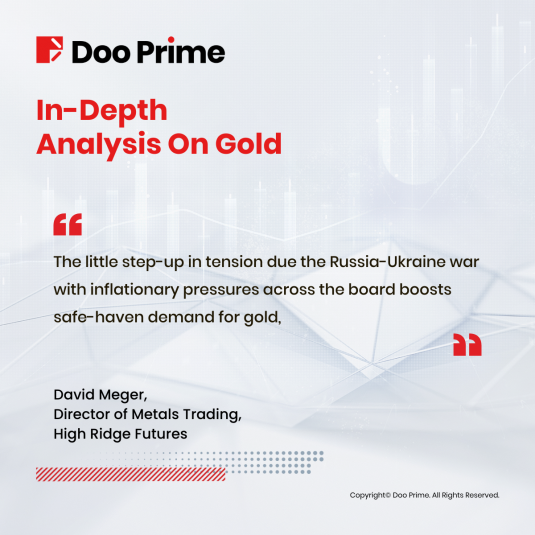
Although concerns of soaring inflation boost gold’s safe-haven appeal, interest rate hikes to temper higher prices could hurt demand for the metal because of the higher opportunity cost of holding non-yielding bullion.
“From a technical perspective, spot gold may face little resistance once it goes north of $2,000… However, gold’s ability to keep its head above $2,000 may be strained once real yields break into positive territory,” Han Tan, chief market analyst at Exinity, said.
Check out our take on What’s Going On With The Global Markets & Economy, In The Face Of The Russia-Ukraine War to see the clearer picture of the cause in high-risk aversion in the international financial markets.



